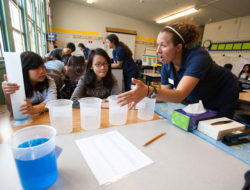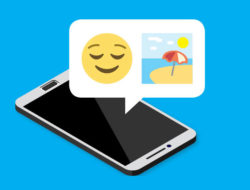Gone are the days of making baking-soda volcanoes in class. Kids today are building robots and plugging in to the latest tech.
When a technology giant like Qualcomm wants to reach young minds capable of inventing the Next Big Thing, they start with a cohort of already sophisticated tech consumers: middle schoolers.
They may care more about smartphone apps than college applications, but now’s the time to stoke young people’s interest in careers in science, technology, engineering, and math—collectively known as STEM.
“Qualcomm employs more engineers than any other discipline, and our future depends on a steady workforce of talented and diverse engineers,” says Susie Armstrong, Qualcomm’s senior vice president of engineering. “We are increasing the awareness of STEM career paths, and inspiring and nurturing the next generation of inventors.”
STEM education, which becomes STEAM when it incorporates the arts, is increasingly provided by schools, after-school programs, and summer camps as a means of producing scientifically literate critical thinkers. STEM activities are often interactive and fun, designed to show kids that the same smarts they use to build Minecraft worlds and Lego robots can translate into good jobs down the road.
Thinkabit

A robotics workshop at Qualcomm’s Thinkabit Lab.
Armstrong leads Qualcomm’s Thinkabit Lab, a hands-on maker space at the company’s corporate headquarters that has taught STEM curricula to more than 8,000 local students since it opened in 2014. Thinkabit Lab is expanding beyond the corporate site, spawning Thinkabit “hubs” and school-based labs throughout the San Diego region under Qualcomm’s stewardship.
Thinkabit Lab has also offered a two-week summer camp program called Qcamp to the same 30 middle-school-age girls every year for the past three years. The girls are hooked—retention in the multiyear program has been 100 percent.
In summer 2016, Qualcomm offered Qcamp to an additional group of girls, as well as a coed, one-week program to incoming sixth graders in the Vista Unified School District.
It helps that the coursework is disguised as play. Students in Thinkabit Lab are taught code that can power LED lights and move motors. They learn about the complexities of light and the building blocks of computer vision. They can even program robots and control them wirelessly with smartphones.
Boys & Girls Clubs

The STEM after-school program at the Boys & Girls Clubs of Greater San Diego.
The Boys & Girls Clubs of Greater San Diego offers after-school STEM programs at seven of its 19 countywide locations. The programs have grown tremendously since the organization began with a STEM pilot program at its Linda Vista branch in 2012.
These aren’t the shoebox dioramas of yesteryear. For a nominal annual fee of $40, Boys & Girls Club members can learn robotics, computer coding, physics, biology, energy conservation, and even stop-motion photography for clay animation.
Brandon Horrocks, the regional Boys & Girls Clubs’ vice president of operations, says he’s especially proud of the clubs’ high school robotics team—they call themselves The Dragons—which has competed in worldwide robotics championships. The teens also mentor local elementary school children in robotics using the latest Lego Mindstorms kits, which contain software and hardware to build custom robots.
“We know that their membership in the club opens the doors to many avenues of growth and learning that their peers do not get to experience firsthand,” Horrocks says.
The Boys & Girls Clubs are able to offer these STEM programs thanks in part to community and parent volunteers, partnerships with local universities including USD and UCSD, and with funding and mentorship from supporters including Qualcomm, San Diego Gas & Electric, Raytheon, IDEX Corporation, and Sony.
Horrocks says new partnerships will be coming online in the coming months, resulting in even more STEM initiatives.
Shannon Trujillo is the Boys & Girls Clubs of Greater San Diego’s STEM coordinator. She says the STEM programs offered by the clubs go a long way toward “reducing the opportunity gap” for underserved children in our communities.
“This is the direction everything is going, especially in a STEM hub like San Diego,” Trujillo says. “We’re fortunate that there are so many local resources to tap into.”
ThoughtSTEM
ThoughtSTEM is the brainchild of three recent UCSD PhD graduates: Stephen Foster, Lindsey Handley, and Sarah Guthals. They met, appropriately enough, at a university-sponsored hackathon. The trio were tutoring kids in computer sciences when they recognized a growing demand for extracurricular STEM programs, particularly in the area of coding.
Video games seemed like an obvious way to make STEM topics more accessible to the younger generation.
Since 2012, they’ve expanded their computer science services throughout San Diego and developed a proprietary education software that’s attracted federal grant funding.
ThoughtSTEM now offers online and in-person classes in Minecraft “modding” (modifying the game’s code to change its appearance, rules, or to or make entirely new games within it); after-school coding classes at some 40 schools; college credit computer science classes for kids ages 8 to 18 through UCSD Extension; weekend coding sessions at UCSD and the Lawrence Family Jewish Community Center; and half-day summer camps at the Reuben H. Fleet Science Center.
Handley, the company’s COO, estimates that ThoughtSTEM has reached at least 5,000 San Diego students so far.
“We want them to internalize those computer science basics,” she says. “We think that if they understand them so young, it won’t feel so nebulous.”
The National Science Foundation has backed the development of ThoughtSTEM’s Minecraft-based software LearnToMod with grant funding, including a $750,000 Small Business Innovation Research grant in August 2016.
The software lets students access Minecraft modding tutorials over a secure server. ThoughtSTEM estimates the program has reached 50,000 students, who in turn have produced over 1.5 million Minecraft mods.
“There’s so much technology that kids are using, but once you get them manipulating the technology, they feel all this power,” Handley says. “It’s so fun to see this moment when they go from being consumers to being creators.”
Gimme an A for STEAM!
If young Albert Einstein had not played the violin, would he have been able to develop the theory of relativity? We have no way of knowing for sure, but researchers have long agreed that there is a developmental link between the arts and sciences. A recent study by Michigan State University found that 93 percent of graduates in STEM subjects had musical training at some point in their lives, as compared to only 34 percent of average adults. —Kim Richards, Hatch Vol. 1, No.1






























